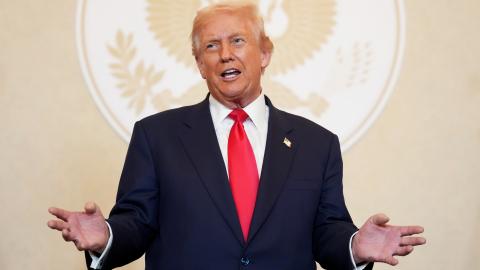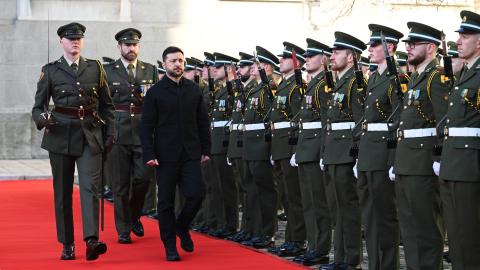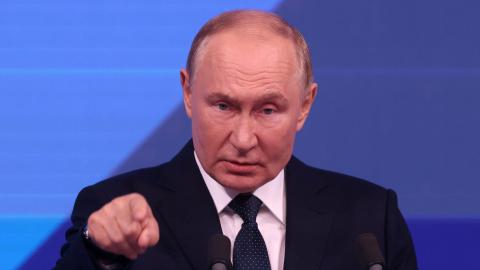Putin’s Way of War
“I am convinced that the future of Russia is fully European,” said French President Emmanuel Macron from his Mediterranean summer residence after hosting Russian President Vladimir Putin there in August 2019. “We believe in a Europe which stretches from Lisbon to Vladivostok.”
To be fair, Macron is not alone in having been deceived. Putin has made a career of hoodwinking Westerners. Conservatives seduced by the romance of Russian nationalism, businesses addicted to cheap Russian energy, intellectuals enamored of the high culture of Moscow and St. Petersburg, progressives determined to build a better world: the Russian President has made marks of them all.
By the time Putin’s admirers discover they have been targets—if this realization hits them at all—the Kremlin finds a new Western quarry and begins the cycle anew. Putin pockets unilateral concessions from the West with one hand and thrusts his dagger at the European order with the other.
Russia accomplished its decade-long military modernization, for example, by raiding the West’s technology base in plain sight. And while the North Atlantic Treaty Organization (NATO) put careful constraints on its own military deployments in Russia’s “near abroad,” Putin established anti-access/area denial bubbles from Tartus in the Eastern Mediterranean to Crimea in the Black Sea and Kaliningrad in Northern Europe—all funded by energy sales to the West.
Putin often disguises his stratagems with creeping incrementalism, like a man boiling a frog alive by imperceptibly increasing the temperature of the water in which it sits. When not executed gradually, his ruses require quick, dramatic successes that give off an impression of inevitability. In this fashion, Putin’s thunder run on Kyiv in February 2022 was meant to impress upon the world that Ukraine was nothing more than an artificial creation.
To Putin’s chagrin, the war in Ukraine has fit neither the incremental nor the blitzkrieg mold. Instead, Ukraine has exposed Putin’s methods for all the world to see. Thanks to Ukraine’s tenacity, the West is now fully awake to Putin’s irredentist brutality. Macron no longer talks about cooperating with Russia but muses aloud about deploying French troops to defend Ukraine.
Still, NATO has yet to launch a new Russia reflection process since at least the Warsaw Summit of 2016, despite dramatic changes to the European security landscape including increasing Sino-Russian cooperation. Perhaps this is because of the sheer enormity of the challenge. As one White House official put it during a roundtable attended by this author in May, “Is containment of Russia even possible given its relationship with China?”
Having squandered Western goodwill and revealed his intentions in Ukraine, Putin is now betting that the West will resign itself to his designs. In this context, Sino-Russian alignment is not a secret he works to disguise, but a fait accompli he parades in the open as a demonstration of strength. When General Christopher Cavoli, NATO’s Supreme Allied Commander, told the U.S. House Armed Services Committee in April that Russia had lost over 2,000 tanks and 315,000 soldiers in Ukraine but was “reconstituting that force far faster than our initial estimates suggested,” it led some to ask whether stopping Russia in Ukraine was even possible.
Putin has worked assiduously to position himself as the indispensable man—the only firefighter in position to extinguish the blaze he has just ignited. As the Swedish analyst Fredrik Löjdquist observed to this author, Putin constructs his war narratives to maneuver the West into the position of supplicant. From February to October 2022, only Putin could forestall the nuclear war that he alone was threatening. In spring and summer 2023, only Putin could contain the fissiparous forces of Yevgeny Prigozhin, which Putin himself had conjured to life. Now, many in the West believe that engaging with Putin may be necessary to end a stalemated war of his own creation. The West burnishes Putin’s status while simultaneously denouncing him.
Ominously, Russia is also proliferating key technologies to Iran, North Korea, and Belarus. By supplying Tehran or Pyongyang with everything from S-300 air defenses and anti-stealth radars to drone systems and satellite technologies that also advance Iran’s ICBM program, Russia is leveling up the technology base of the anti-American axis—and getting the White House’s attention in the process. If Moscow takes further steps, such as delivering Su-35 air superiority fighters and S-400 air defenses to Iran or North Korea, its defense partnerships with Tehran and Pyongyang will constitute the most significant and rapid military upgrades of two anti-American regimes in modern history. Putin has also completed an outright takeover of the security sector in Belarus, where he has deployed Iskander missiles, conducted tactical nuclear weapons drills, and dispatched Wagner Group instructors to train the Belarusian military. The distance from Brest, in Belarus, to Warsaw, Poland, is a little more than 100 miles.
For now, Russia is unlikely to engage in large-scale conventional war with the West, especially since NATO continues to flex its muscles through exercises like Steadfast Defender and BALTOPS. Yet the degradation of Putin’s land-forces in Ukraine raises the likelihood that he engages in high-end nuclear saber-rattling and low-end hybrid attacks over the next several years. From misinformation campaigns to illicit funding operations, Moscow has modernized the active measures playbook it has been using for years.
Putin continues to load his revolver with one bullet after another in anticipation of a showdown. When negotiations on Ukraine commence—and that day will eventually come—Putin will place his gun at the center of the table, point it directly at the West, and demand that the world accept his terms.
What’s at Stake
The peace and prosperity of Europe remains a vital national security interest of the United States. The continent provides two-thirds, or about $3.4 trillion, of total foreign direct investment (FDI) in the United States, while the United States has over $4 trillion in FDI stock invested in Europe, some 60 percent of total U.S. assets abroad. Those numbers are only set to grow.
The trading relationship between the United States and Europe also remains the world’s largest, with annual two-way trade reaching approximately $2 trillion in total volume. Europe may be an innovation laggard, likely to fall behind the Americas and Asia in the coming decades, but for the foreseeable future it will remain one of three major power centers of the global economy. So long as that is the case, the United States will work to maintain a favorable balance of power in Europe informed by the lessons of the last century.
Today, Europe is the United States’ forward operating base on the Eurasian landmass, from which Washington can project power into Africa, against Russia, and throughout the Middle East. The U.S.-built European order offers advantages for the United States in regions far beyond its reach. If the United States and China come to blows in the South China Sea, Washington would expect Europe to join it in an economic campaign against Beijing—occasional comments by some Europeans notwithstanding—lest European inaction undermine the United States’ transatlantic commitment.
The prospect of Europe joining the United States in an economic campaign against China surely factors into Beijing’s near-term calculations of war and peace. China’s economy is riddled with structural deficiencies. As Europeans have repeatedly told this author, officials in Beijing complain regularly that the United States has begun to counterbalance China before China has grown strong. A Chinese attack on Taiwan would spawn a coalition of the world’s advanced economies, including Europe, which would only exacerbate Beijing’s economic woes. Chinese President Xi Jinping would need to risk his global ambitions for a high-stakes Taiwan operation with no guarantee of success. History is full of leaders who have taken such gambles, but Europe’s ability to shape calculations in the Taiwan Strait while the continent remains an economic power cannot be dismissed out of hand.
Ukraine and NATO
This is one reason why Western support for Ukraine in its war against Russia carries a significance that transcends that conflict. By backing Ukraine, NATO protects the European order without deploying Cold War-era levels of U.S. forces on the continent. Ukraine also serves as the case study that Chinese leaders will examine most closely to infer how the West might respond to an attack on Taiwan. Whatever interlude may exist between Russia’s full-scale attack on Ukraine and China’s possible invasion of Taiwan gives the West time to begin military production lines that otherwise would not exist.
Ukraine is now on the military defensive. Summer 2024 has been harrowing for the country, as Russia applies increasing pressure. During this time of hardship, the fighting near Kharkiv illustrates why the United States should lift the restrictions it has placed on how Ukraine is allowed to use U.S. armaments. Kharkiv sits only a few dozen miles from the Russian border, yet until recently, Ukraine’s forces have been restricted from using Western-supplied weapons against formations inside Russia. After the United States and its partners reversed this policy, Ukraine’s battlefield fortunes improved. It is past time for President Joe Biden’s administration to end its tepid approach to security assistance, which dates to even before Russia began its full-scale invasion.
Absent outright conquest of Ukraine, which remains Putin’s preferred path to victory, the Kremlin’s strategy seems clear: weaken Ukraine by choking its access to the outside world, especially its Black Sea coastline, before absorbing it as a rump state into the Russian Federation. Unsurprisingly, Ukraine’s war aims are the exact opposite: preserve commercial operations, especially at the port of Odesa, and beat back the Russian occupation as far as possible, including in Crimea.
The war’s front lines may ebb and flow, and a ceasefire may even interrupt the fighting, but the only real path to Ukraine’s long-term security is NATO membership. The bilateral security agreements Western countries are now negotiating with Ukraine can serve as a temporary bridge to Euro-Atlantic integration, but they cannot be the last step, as it would be near impossible to equip Ukraine to a level where it enjoys an edge over Russia akin to what Israel enjoys in the Middle East or South Korea possesses over North Korea. Moreover, Israel possesses nuclear weapons—a fact not lost on Ukraine—while South Korea benefits from America’s extended nuclear deterrent. Instead, Kyiv will be mostly disappointed by this summer’s Washington Summit, where NATO will not extend an invitation to join the alliance. This leaves Ukraine in a state of limbo, fighting for its existence.
U.S. Policy Considerations
Of course, Putin will attempt to counterprogram the Washington Summit. While one can only guess what he has up his sleeve in the coming months, the United States should seek to preempt his moves.
To this end, NATO should deploy forces along the Poland-Belarus border to give authorities in Minsk a pretext to keep their own troops in garrison rather than support a renewed attack on Ukraine. This would also send a signal to Beijing.
If tightening sanctions on Russia is not possible in an election year, then the United States should at least explore how to catalyze greater capital flight from Russia. Similarly, if the Biden Administration will not overhaul its energy policy, it should at least reconsider its moratorium on liquid natural gas exports and launch an initiative to encourage Russian defense clients like India to consider alternate suppliers. Both moves would weaken Russia’s economy.
Other opportunities abound. The accession of Finland and Sweden to NATO flips the script in Northern Europe. In the span of two years, NATO has turned the Russian exclave of Kaliningrad into a liability for the Kremlin and the Gulf of Finland near St. Petersburg into alliance waters. Russia is off-balance, and NATO should not allow it to regain its footing.
Russia’s underperformance in Ukraine has also created a moment of opportunity in the post-Soviet states. In the Caucasus, Washington is supplanting Moscow as a mediator between Azerbaijan and Armenia. In Central Asia, the United States can exacerbate friction between Russia and its security partners such as Kazakhstan. In Georgia, Washington missed an opportunity for early sanctions against Bidzina Ivanishvili’s government over a foreign funding law, and instead belatedly issued a milquetoast reprimand before ratcheting up the pressure. This fall, the next opportunity arises for the United States to roll back Russian influence when Moldova holds presidential elections and a referendum on European Union membership.
The United States leads its 30 treaty allies across the continent by forging a common strategic outlook and assigning missions and roles. Yet none of this is meaningful if the alliance lacks troops and warfighting capabilities. More than two years after Russia’s full-scale invasion, Europe has made progress, but it still suffers from gaps in air enablers, air defenses, naval forces, munitions, and other key capabilities. Its recruitment woes mirror those in the United States.
No matter who occupies the White House next year, the United States must convince Europe to turn pledges into commitments and those commitments into capabilities. Washington should exert sustained pressure on its European allies to go beyond their Wales Pledges. The days of cultivating Russia or fantasizing about wedging strategies that separate Moscow from Beijing are over. It is time for the West to push back on Russian aggression, signal to China that the costs of war are high and invest in its own military strength.
Read in Ronald Reagan Presidential Foundation.
Enjoyed this article? Subscribe to Hudson’s newsletters to stay up to date with our latest content.


















